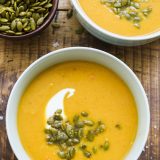For a fresher, more flavorful take on all-American butternut squash soup, we had to rethink much of what we thought we knew about Indian food.
Screenwriter Sri Rao was our guide. He explained that the rich curries and deep-fried breads found in most Indian restaurants in the U.S. actually aren’t typical of the foods served in Indian homes. That’s because the initial wave of Indian restaurants here and elsewhere was led by cooks from Punjab—a state in far-north India that borders Pakistan and has a heavier, richer cuisine than India’s southern regions.
Indian food made at home is lighter and simpler, less meat-centric and oil-laden. And in the U.S., recipes often feature quintessentially American ingredients, marrying them to traditional Indian flavors and cooking techniques.
In Rao’s cookbook “Bollywood Kitchen,” he follows that lead, just as his mother did during his childhood in central Pennsylvania. Ground beef replaces minced lamb in a dry curry, black mustard seeds and turmeric transform pan-roasted Brussels sprouts, and canned kidney beans make a quick rajma, a hearty vegetarian stew.
We were especially intrigued by Rao’s update to an American classic—butternut squash soup. Using a time-tested Indian technique, he creates an intensely flavorful base by blooming a paste of ginger, cumin, coriander, cinnamon and Indian chili powder in softened onions. He then adds chunks of squash and vegetable stock. Once cooked, the squash is blended into a smooth, boldly spiced soup.
“This recipe would be instantly recognizable to an Indian,” Rao says. “Because with the spices, it feels familiar, but the butternut squash makes it distinctly American.”
For our version, we added carrots to reinforce the squash’s natural sweetness and bright orange color, and we switched to water instead of stock, which let the soup’s flavors shine more clearly. We sautéed hunks of squash and carrots, plus onion, in olive oil first, developing deeper, earthier flavor before adding the spices. Once browned, we stirred in ginger, coriander, cumin, cayenne and salt—omitting only the cinnamon—and allowed the spices to bloom.
As the soup simmered, we turned our attention to spicy pumpkin seeds, which Rao uses to garnish his soup.He roasts them in the oven, but we found toasting them in a skillet with a bit of cayenne and a little salt produced similar results more easily.
After the soup cooled slightly, we pureed it to a smooth consistency. Stirring in ½ cup plain yogurt added acidity and a bit of body; another dollop as garnish highlighted the soup’s tang. And a final sprinkle of the spicy pumpkin seeds gave us some welcome crunch.




